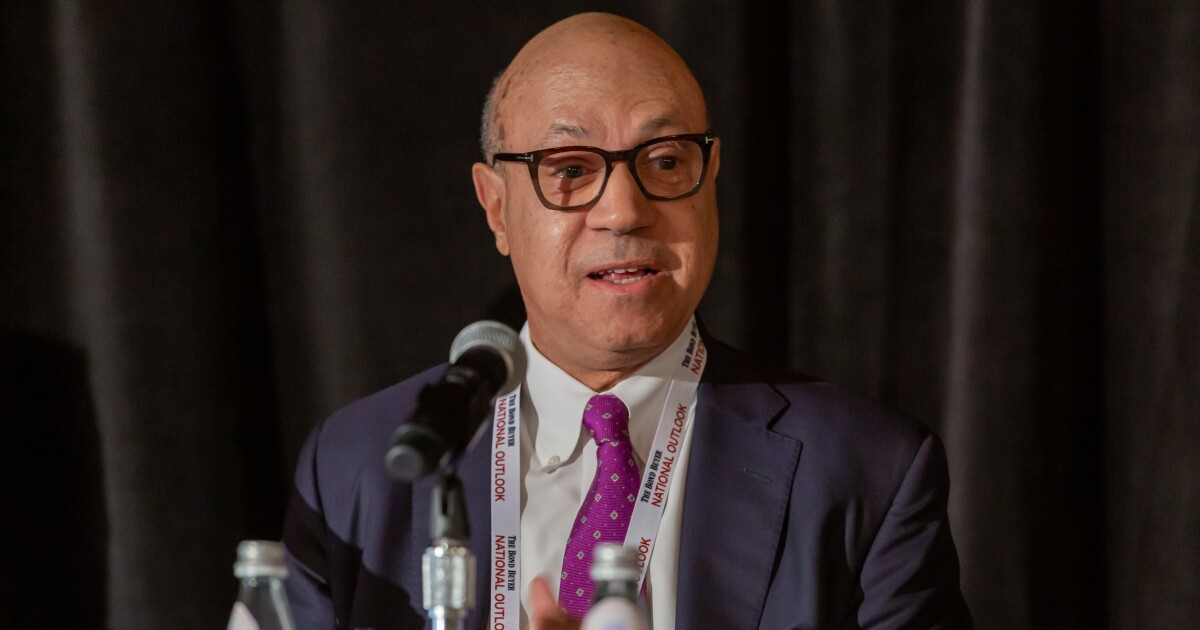New York City sets $678M GO sale
5 min read
New York City is heading to market with the biggest municipal bond deal of the holiday-shortened week, a $677.45 million tax-exempt general obligation bond offering that will refund some outstanding debt.
Lead managers Siebert Williams Shank, BofA Securities and RBC Capital Markets are set to price the fiscal 2023 GOs for institutions on Wednesday after a one-day retail order period Tuesday.
The deal consists of $559.65 million of Series C GOs, due Aug. 1, 2023 to 2034, and $117.81 million of Series D GOs, due Aug. 1, 2023 to 2034. The GOs are being issued as multi-modal bonds in the fixed-rate mode.
Co-managers include Academy Securities, Barclays, Blaylock Van, BNY Mellon Capital Markets, Cabrera Capital Markets, Citigroup, Drexel Hamilton, Fidelity Capital Markets, Goldman Sachs, Great Pacific Securities, Janney Montgomery Scott, Jefferies, J.P. Morgan Securities, Loop Capital Markets, Morgan Stanley, Oppenheimer & Co., Ramirez & Co., Raymond James, Rice Financial Products Co., Roosevelt & Cross, Stern Brothers, Stifel, Nicolaus, TD Securities, UBS and Wells Fargo Securities.
PRAG and Acacia Financial Group are the financial advisors while Norton Rose Fulbright and Bryant Rabbino are the bond counsel.
The bonds are rated Aa2 by Moody’s Investors Service, AA by S&P Global Ratings, AA-minus by Fitch Ratings and AA-plus by Kroll Bond Rating Agency. Fitch has a positive rating on the GOs while Moody’s, S&P and KBRA maintain a stable outlook on the bonds.
The rating “reflects city’s competitive advantages, which include a young and highly skilled labor pool, access to higher education and medical centers, normally strong domestic and international transportation links and low crime rates relative to other large cities,” Moody’s said Friday.
The rating also reflects the city’s strong institutional budgetary and financial management and the breadth and diversity of its revenue base, Moody’s said.
“The city’s financing responsibilities are broader than most local governments, since it is a city, five counties and the nation’s largest school district and its debt burden is above-average because of this operational scope,” Moody’s said. “Despite those responsibilities, the city’s fixed costs for debt service, pensions and retiree healthcare are below the median for the largest local governments and in the bottom five among the nation’s largest cities.”
Retail investors will have one day to place orders for the GOs, a change from prior years when two-day retail order periods were the norm. But the historical two-day retail period has gone by the wayside, due to recent muni market volatility, officials say.
“The way we structure debt and the way we approach the market” has changed, David Womack, deputy director for financing policy and coordination in the Mayor’s Office of Management and Budget, said at The Bond Buyer’s National outlook conference earlier this month.
“Those who have followed us for many years know we typically issued our GO and TFA debt with a two-day retail order period followed by a one-day institutional order period,” said Womack, who is also executive director of the New York City Transitional Finance Authority, CEO of the NYC Municipal Water Finance Authority and president of the Hudson Yards Infrastructure Corp.
“As we spoke with our underwriting partners and our municipal advisors, given that volatility, we shortened that retail order period to one day,” he said. “We felt it was not in our interest to have bonds in the market for three straight days, running the risk of rates going up or going down — so we had to compress that issuance calendar.”
The city is one of the biggest issuers of municipal bonds in the nation. In the fourth quarter of fiscal 2022, it had about $38.8 billion of general obligation bonds outstanding. That doesn’t include various agency debt, such as the TFA or the MWFA, which have $44 billion and $32 billion outstanding, respectively.
Looking at the economic landscape, state Comptroller Thomas DiNapoli reported Friday the city’s sales tax collections totaled $844 million in January, a rise of 8.8%, or $68 million, compared to a year earlier.
Statewide, local sales tax collections increased 9.2% in January on a year-over-year basis. Overall, local collections in the state totaled $1.89 billion, up $159 million from 2022.
In December, the city added over 20,000 private-sector jobs bringing the total to 4.021 million, 97.9% of the pre-pandemic peak, according to the monthly economic and fiscal outlook report issued by city Comptroller Brad Lander.
Employment in health care and social assistance increased by more than 18,000 in the fourth quarter of 2022, while jobs in food and hospitality rose over 14,000. However, employment in retail businesses fell in December and remained 13% below the pre-pandemic level.
The city’s seasonally adjusted unemployment rate was 5.9% in December, higher than the U.S. rate of 3.5%.
Personal income tax withholding collections totaled $1.19 billion in January, up 6.7% from January 2022.
“After adjusting for estimated collections on base salary, and calendar differences, our tracking estimate of bonus payments continues to indicate a decline of around 20% for this year’s high season for bonuses, measured thus far from early December through early February,” the report said.
The city’s Department of Finance’s tentative property assessment roll for fiscal 2024, included a 6.0% increase in the taxable assessed value for Tax Class 1 properties, which are most residential properties of one to three units. It was the largest increase in the last 10 fiscal years, the report said.
Although the office market continues to see elevated vacancy rates, the market value of Class A office buildings rose 7.1%.
Condo office parcels, which are 16% of total office market value, saw the highest percentage increase, 8.6%. The market value of non-condo hotel properties increased by 8.3% while condo hotel properties increased 12.2%.
Total market values for Manhattan rental buildings dropped 2.6%. Total market values for Manhattan cooperative buildings decreased 1%.
The report noted the city’s current cash balances are at a historical high. As of Feb. 2, the city’s cash balance is at $14.6 billion compared to $7.2 billion at the same time last year. There is $1.954 billion in the revenue stabilization fund, the city’s rainy-day fund.
In December, NYC & Company said it expected the city would have seen 56.4 million travelers in 2022, a rise of 71.4% over 2021. The official marketing organization for the city noted this would represent 85% of the pre-pandemic record high of 2019.
It noted the rebound would provide about $40 billion in direct visitor spending out of the $60 billion in total economic impact for 2022.
Both New York City and New York State are currently negotiating their budgets for fiscal 2024. The city’s fiscal year begins July 1 while the state’s fiscal year starts April 1.
Mayor Eric Adams released his preliminary $102.7 billion fiscal 2024 budget proposal in January. The plan is up from the final $101 billion fiscal 2023 budget the mayor and council agreed upon last June, but is lower than the $104 billion in the revised plan put forth in the mayor’s November modification.
Gov. Kathy Hochul unveiled a $227 billion executive budget proposal earlier this month, it’s up 2.4% from the final $220 billion fiscal 2023 budget that was approved last April.
The state’s GOs are rated Aa1 by Moody’s, and AA-plus by S&P, Fitch and KBRA.
New York not only topped the Northeast as usual as a source of municipal bonds, but also led the entire country. Issuers in the Empire State sold $49.4 billion of bonds in 2022, up 2.3% from 2021. New York not only bucked the national trend with higher volume, it did so with 531 transactions, down from 777 deals sold in 2021.







